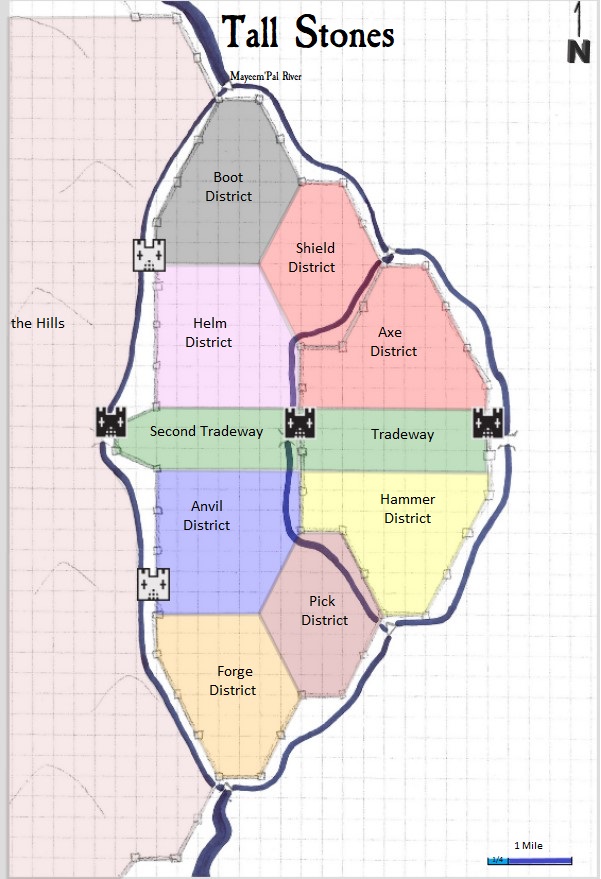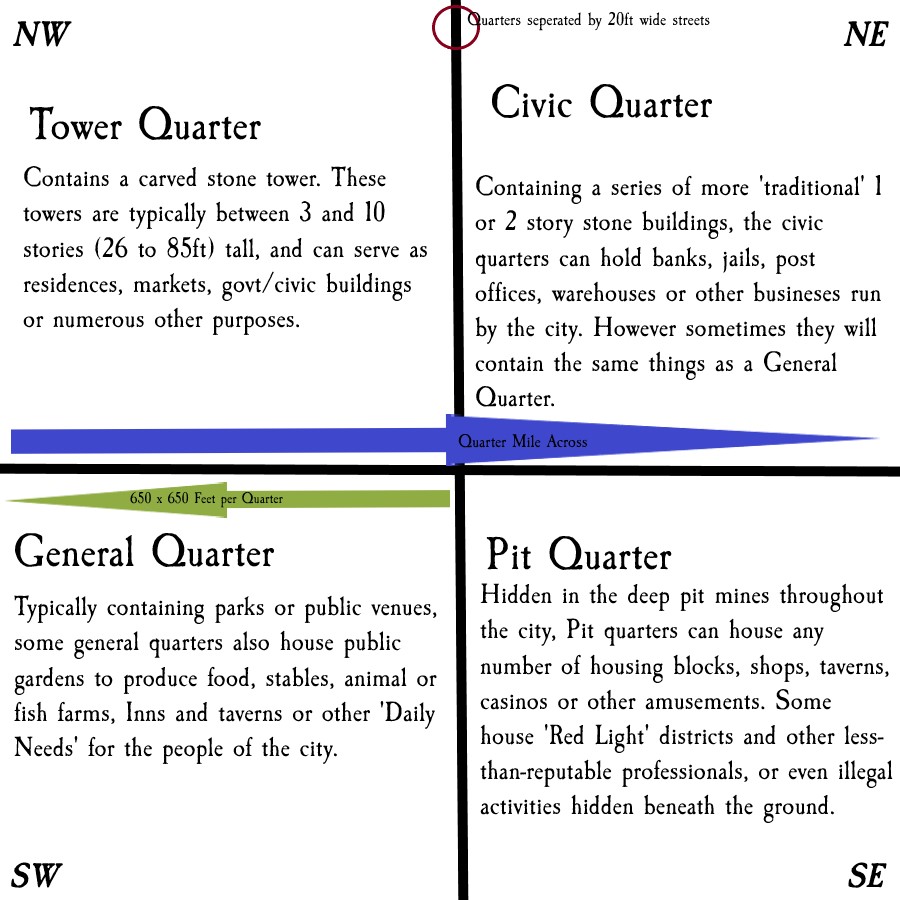Tall Stones
Demographics
- Dwarf: 75%
- Goblin: 6%
- Halfling: 5%
- Kobold: 4%
- Other: 10%
Government
Each arm of the government provides 4 representatives, voted for once every 2 years by the people of the city. A council member's term is 2 years.
In addition there is a city-wide vote once a year to elect a independent 17th council member from the citizenry who is intended to act as a tie-breaker in votes as well as represent the peoples of the city not related to the 4 main areas of government.
A council member can serve no more than 2 terms within a 20 year span.
Defences
The massive stone wall, standing over 60ft high in most places, and it's sturdy towers standing a full 20 feet above even that, provide excellent defense against traditional attacks from the North, East, and South. However, as the city expands West, portions of it were eventually built in the exposed western portions. To solve this, the city was, over time, closed off into distinct districts capping off the city at that time with more walls on the west side until it again be gain to extend beyond this wall.
The walkways atop the wall are wide, allowing four dwarves to comfortably walk side-by-side on it's top parapets, without those walking on the ends even being worried of falling off the sides. The tops of the walls are also defended by 3ft tall and 3ft wide Crenelations as well as every other crenelation having a narrow Machicolation (or 'Murder Hole') for defending troops to fire arrows or crossbow bolts down on attacking forces without having to step around the defensive battlements.
Industry & Trade
Primary Exports: Stone used for construction, Gold and other Precious metals, Jewels.
Chief Imports: Lumber, Grain.
Assets
Tradeway: Encompassing the primary East to West street and markets, as well as the First East Gate, this section of the city is constantly busy with travelers, merchants and other business.
Axe District: The first of the Military quarters, this area of the city primarily houses and trains the military and governmental forces of the city.
Hammer District: The first of the craftsmen quarters, this part of the city includes many illustrious smithies, armorers, carriage makers, stonemasons, and jewelers.
Second Tradeway: The continuation of the Tradeway past the second gate, this area still has numerous merchant squares, warehouses and market stalls.
Boot District: Consisting primarily of civilian housing and clothing manufacture, this area houses many middle and lower class citizens.
Shield District: The second Military quarter, this area specializes in weapons and armor manufacture, repair and storage to equip the combined forces of Tall Stones. It also has training yards, military and government housing, as well as stables.
Helm District: Primarily a government quarter, this part of the city holds the Council tower, many smaller government offices, libraries and document storage facilities and many other bureaucratic facilities.
Anvil District: A crafting quarter, this part of the city has many craftsmen halls, guilds, and manufacturing facilities. Crafts most general goods, as well as potions and jewelry, but not much in the way of weapons and armor.
Pick District: A Mining quarter, this part of the city holds most of the mining, engineering and tunneling facilities. Mining equipment is also built and maintained here.
Forge District: Manufacturing most of the non-military weapons and armor in the city, as well as general smithy work, this area of the city is often ringing with the sounds of roaring bellows and smelters.
The last portion of the city is simply known as 'The Hills'. This area is the undeveloped sprawl west of the city, where the city is working to expand itself into in the future. Many areas of this place are already showing small mining and landscaping or flattening projects, as well as the foundations of future buildings beginning to pop up between the soon-to-be mined flat hills.
Guilds and Factions
The Gold-Born Guild: Craftsmen and artisans, specializing in jewelry, fine metals and gems.
Wildlands Adventure Company: A loose, though very large, group of adventurers and mercenaries.
The City Council: The main ruling body of the city government.
Forgemasters of Firecaste: Weapon crafting guild, also serves as a 'church' of craftsmanship and the forge.
Ironheart Masters: Armorsmith guild, also specializes in silk and linen spinning.
The Farmhands: Master farmers, millers, animal breeders and the greatest food producers within the city.
Civic Workforce: The engineers, crafters and experts in charge of maintaining the city infrastructure.
History
Architecture
The former pit mines are skillfully converted into different living and merchant districts. Ringed with descending spiral stairwells and platforms, some of the deep pits are also capped with suspended gardens or windmills.
Geography
The Mayeem'Pal (Water over Pebbles) River flows from the north, and was diverted through and around the city to act not only a a moat, but irrigation and aqueducts.
Natural Resources
Visual Key to the 1/4 mile 'Blocks' of the city, each broken down into four 650ft 'Quarters'






Comments